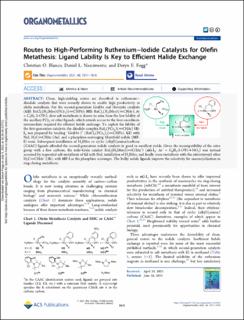Routes to High-Performing Ruthenium–Iodide Catalysts for Olefin Metathesis: Ligand Lability Is Key to Efficient Halide Exchange
Journal article, Peer reviewed
Published version

Åpne
Permanent lenke
https://hdl.handle.net/11250/2988264Utgivelsesdato
2021Metadata
Vis full innførselSamlinger
- Department of Chemistry [433]
- Registrations from Cristin [9766]
Sammendrag
Clean, high-yielding routes are described to ruthenium–diiodide catalysts that were recently shown to enable high productivity in olefin metathesis. For the second-generation Grubbs and Hoveyda catalysts (GII: RuCl2(H2IMes)(PCy3)(═CHPh); HII: RuCl2(H2IMes)(═CHAr), Ar = C6H4-2-OiPr), slow salt metathesis is shown to arise from the low lability of the ancillary PCy3 or ether ligands, which retards access to the four-coordinate intermediate required for efficient halide exchange. To exploit the lability of the first-generation catalysts, the diiodide complex RuI2(PCy3)(═CHAr) HI-I2 was prepared by treating “Grubbs I” (RuCl2(PCy3)2(═CHPh), GI) with NaI, H2C═CHAr (1a), and a phosphine-scavenging Merrifield iodide (MF-I) resin. Subsequent installation of H2IMes or cyclic (alkyl)(amino)carbene (CAAC) ligands afforded the second-generation iodide catalysts in good to excellent yields. Given the incompatibility of the nitro group with a free carbene, the iodo-Grela catalyst RuI2(H2IMes)(═CHAr′) (nG-I2: Ar′ = C6H3-2-OiPr-4-NO2) was instead accessed by sequential salt metathesis of GI with NaI, installation of H2IMes, and finally cross-metathesis with the nitrostyrenyl ether H2C═CHAr′ (1b), with MF-I as the phosphine scavenger. The bulky iodide ligands improve the selectivity for macrocyclization in ring-closing metathesis.
